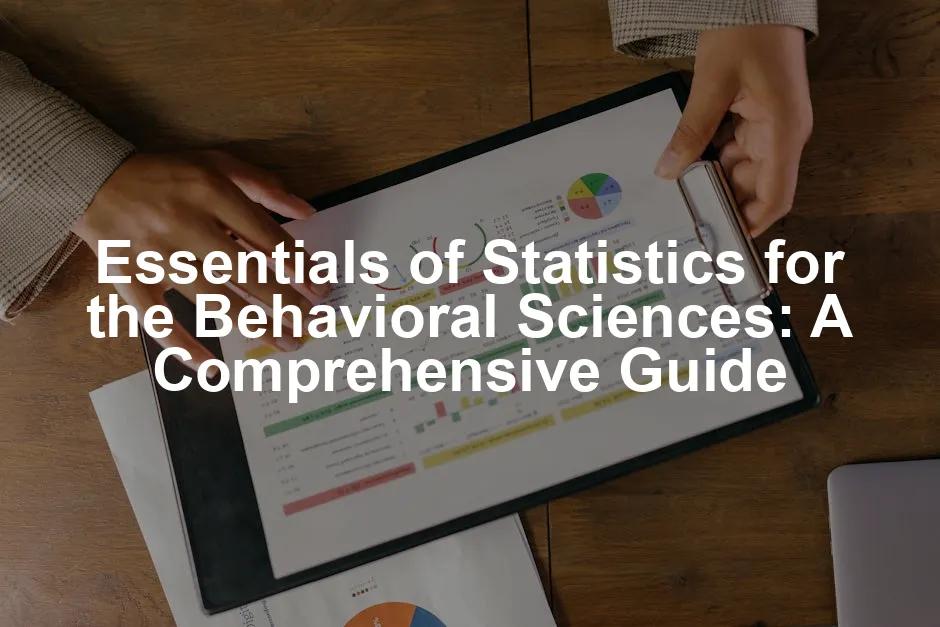Introduction
Statistics is the backbone of behavioral sciences. It helps researchers and practitioners make sense of complex data. Without statistics, interpreting research findings would be like trying to find Waldo in a sea of red and white stripes—impossible and frustrating!
In the behavioral sciences, understanding statistics is crucial. It enables professionals to conduct studies, analyze data, and interpret results accurately. Imagine making decisions based on flawed data. Yikes! The consequences could be dire.
A solid grasp of statistics empowers researchers to sift through data like pros. It allows them to discern patterns and relationships that inform their work. Whether you’re a psychologist, sociologist, or counselor, statistical knowledge is your best friend.
This article aims to provide a comprehensive overview of the essentials of statistics tailored to behavioral sciences. From basic definitions to types of statistical analysis, we will cover it all. So grab a snack and get comfy; let’s embark on this statistical adventure!

Speaking of snacks, you might enjoy munching on some healthy treats while you read! Check out this Healthy Snack Box that will keep you energized and focused!
Understanding the Basics of Statistics
What is Statistics?
Statistics is a branch of mathematics that deals with collecting, analyzing, interpreting, and presenting data. In simpler terms, it’s the art of making sense of numbers. Think of it as a magnifying glass that helps us look closer at data to find meaningful insights.
In the behavioral sciences, statistics plays a pivotal role. Researchers use it to draw conclusions from study findings. For example, if a psychologist conducts a study on stress levels, statistics helps them determine if their results are significant or just random noise. It’s like having a trusty sidekick that tells you, “Hey, this is important!”
Types of Statistics
Statistics can be broadly categorized into two main types: descriptive and inferential.
Descriptive Statistics: These are the numbers that summarize and describe the main features of a dataset. They provide a glimpse into what the data looks like. Key measures include:
- Measures of Central Tendency: This includes the mean (average), median (middle value), and mode (most frequent value). Think of them as the headline news of your data—what’s the main takeaway?
- Measures of Variability: These metrics describe how spread out the data is. Common measures include range (the difference between the highest and lowest values), variance (how much values differ from the mean), and standard deviation (the average distance of each data point from the mean). They help us understand the diversity within our data.
Inferential Statistics: These take us a step further. They allow researchers to make predictions or inferences about a larger population based on a sample. This is where hypothesis testing comes into play. Researchers test assumptions (hypotheses) about their data, often using confidence intervals and significance levels to determine if findings are statistically significant. It’s like taking a small bite of cake to predict how delicious the whole cake will be!

Want to delve deeper into the world of statistics? Consider grabbing a copy of “The Art of Statistics: Learning from Data” by David Spiegelhalter. It’s a delightful read that makes statistics not just understandable but also enjoyable!
Understanding inferential statistics is essential for making predictions based on sample data. the problem with inferential statistics
In summary, understanding these types of statistics is vital for anyone working in behavioral sciences. They help interpret data accurately and enable informed decision-making in the field. So, whether you’re crunching numbers or analyzing behavior patterns, remember that statistics is your trusty guide through the data jungle!
Why Statistics Matter in Behavioral Sciences
Statistics are the unsung heroes of behavioral sciences. They provide the tools to analyze, interpret, and present data that reveal patterns in human behavior. Think about it: how would psychologists determine the effectiveness of therapy without statistics? Statistics help illuminate the connections between various factors, such as stress levels and coping strategies, or social media usage and mental health.
In psychology, statistics guide research design and data analysis. For instance, when studying anxiety disorders, researchers rely on statistical methods to assess the prevalence of these conditions in different populations. This information is vital for developing targeted interventions. Similarly, sociologists utilize statistics to understand social phenomena, such as the impact of education on income levels.

Consider a real-world example: a study examining the effects of meditation on stress relief. Researchers might collect data from two groups—one practicing meditation and the other not. By applying statistical tests, they can determine whether any observed differences in stress levels are statistically significant. Without statistics, researchers would be left guessing, and their findings would lack credibility.
In essence, statistics are the bridge between abstract theories and real-world applications in behavioral sciences. They empower researchers to make informed decisions, ensuring that their work can positively impact lives.
Key Concepts in Statistical Analysis
Data Types and Scales of Measurement
Data is the lifeblood of statistics, and understanding its types is crucial. There are four primary data types: nominal, ordinal, interval, and ratio.
- Nominal data are categories without a specific order. Think of them as labels. For instance, your favorite ice cream flavor—chocolate, vanilla, or strawberry—is nominal data.
- Ordinal data are categories with a clear order but no consistent difference between them. A good example is a satisfaction survey where responses range from “very unsatisfied” to “very satisfied.”
- Interval data have ordered categories with consistent differences but no true zero. For example, temperatures in Celsius can be measured accurately, but zero does not indicate the absence of temperature.
- Ratio data is similar to interval data but includes a true zero, which allows for meaningful comparisons. Consider height or weight—zero means none exists, and you can say one person is twice as heavy as another.
Understanding these scales impacts statistical analysis. For instance, the type of data determines which statistical tests are appropriate. Using the wrong test can lead to misleading conclusions. So, when conducting research, always consider the data type at hand!

Probability and Its Importance
Probability is the foundation of statistics. It helps us quantify uncertainty. At its core, probability measures the likelihood of an event occurring. This concept is essential for making predictions based on sample data.
Imagine you’re trying to predict whether a new therapy will be effective for a group of patients. Probability allows researchers to assess the chances of different outcomes based on previous data. This is crucial for statistical inference, where we draw conclusions about a population based on sample data.
In hypothesis testing, probability plays a central role. Researchers formulate a null hypothesis (no effect) and an alternative hypothesis (some effect). They then use probability to determine if the observed data contradict the null hypothesis significantly. If the p-value is below a certain threshold (commonly 0.05), researchers reject the null hypothesis, suggesting that the findings are statistically significant.

Thus, understanding probability is vital for interpreting research results accurately. It helps researchers navigate uncertainty and make data-driven decisions.
Statistical Distributions
Statistical distributions describe how data points are spread across different values. The normal distribution is a key concept in statistics. It is symmetrical, with most data points clustering around the mean. In behavioral sciences, many traits, such as intelligence, often follow a normal distribution.
But not all distributions are normal. Skewness refers to asymmetry in data distribution. If a distribution has a long tail on the right, it’s positively skewed; if the tail is on the left, it’s negatively skewed. Skewness can affect the choice of statistical analyses and interpretations.

Kurtosis, on the other hand, measures the “tailedness” of a distribution. High kurtosis indicates more outliers than a normal distribution, while low kurtosis suggests fewer. Recognizing skewness and kurtosis helps researchers understand the data’s behavior, guiding them in selecting appropriate statistical methods.
Finally, the Central Limit Theorem (CLT) states that as sample sizes increase, the sampling distribution of the mean approaches a normal distribution, regardless of the original data’s distribution. This theorem is pivotal in hypothesis testing and confidence intervals, making it a cornerstone of statistical analysis.
Understanding these concepts allows researchers to analyze data effectively and draw meaningful conclusions in the field of behavioral sciences.
Hypothesis Testing
Understanding Hypotheses
Hypothesis testing is a fundamental aspect of statistics in behavioral sciences. It begins with formulating two types of hypotheses: the null hypothesis and the alternative hypothesis.
Null Hypothesis (H0): This hypothesis states that there is no effect or no difference. It serves as the default position. For instance, if a psychologist claims that a new therapy has no effect on anxiety levels, that’s the null hypothesis.
Alternative Hypothesis (H1): This is what researchers aim to support. It suggests that there is an effect or a difference. In our therapy example, the alternative hypothesis would claim that the new therapy does indeed reduce anxiety levels.
Formulating these hypotheses is crucial in research. It provides direction for the study and helps researchers focus on what they aim to prove or disprove. Without a clear hypothesis, research can resemble a boat adrift at sea—no destination, no purpose!
Steps in Hypothesis Testing
Hypothesis testing involves several key steps. Here’s how it typically unfolds:
- Define Hypotheses: Clearly state your null and alternative hypotheses. This sets the stage for everything that follows.
- Choose a Significance Level (α): This is the threshold for determining whether to reject the null hypothesis. A common choice is 0.05. If the p-value is less than this, we’ll consider our result statistically significant.
- Collect Data: Gather data through experiments or observations. This is the fun part where you get to see what the numbers reveal!
- Calculate Test Statistics: Depending on your data and hypotheses, you’ll calculate a test statistic (like a t-score or F-value). This helps quantify how far your sample data deviates from the null hypothesis.
- Make Decisions: Compare the test statistic to a critical value, or reference the p-value. If your test statistic exceeds the critical value or the p-value is below α, reject the null hypothesis. If not, fail to reject it. Remember, failing to reject doesn’t mean proving the null hypothesis true; it just means we lack sufficient evidence.

Following these steps ensures that researchers can make informed decisions based on their data. It’s like playing a game of poker; you need to know when to hold your cards and when to go all in!
Common Tests
Let’s explore some common tests used in hypothesis testing.
- t-Test: This is a staple for comparing the means of two groups. When should you use it? If you’re examining whether the average test scores of students who attended a workshop differ from those who did not, a t-test is your go-to. It calculates how much the sample means differ relative to the variability of the data. A significant result suggests a meaningful difference in performance—time to pop the confetti!
- ANOVA (Analysis of Variance): ANOVA is handy when comparing means across three or more groups. There are two main types: one-way and two-way.
- One-way ANOVA examines one independent variable. Imagine testing the effects of three diets on weight loss. You’d compare the average weight loss across the three groups.
- Two-way ANOVA considers two independent variables simultaneously. Picture a scenario where you’re looking at the effects of diet (low-carb vs. low-fat) and exercise (none vs. regular) on weight loss. This test allows researchers to see how these factors interact.
- Chi-Square Test: This test is perfect for analyzing categorical data. It assesses whether there’s a significant association between two categorical variables. For instance, you might want to determine if there’s a relationship between gender (male/female) and preference for a type of therapy (cognitive behavioral vs. psychodynamic). If the chi-square value indicates a significant association, it’s time to update your therapy recommendations!

Understanding these tests is crucial for any researcher in behavioral sciences. They help provide clarity in the midst of data chaos, allowing for insightful conclusions that can influence real-world practices. So, whether you’re conducting a study on therapy effectiveness or exploring social behavior trends, mastering hypothesis testing will make you a statistical superstar!
Regression Analysis
Let’s kick things off with regression analysis! This nifty statistical technique helps us understand relationships between variables. There are two main types: simple and multiple regression.
Simple regression explores the relationship between two variables. Imagine you want to predict someone’s exam score based on the number of hours they studied. Simple regression is your go-to tool!

Multiple regression, on the other hand, takes it up a notch. It allows us to examine the relationship between one dependent variable and multiple independent variables. For instance, consider predicting a student’s academic performance based on their study hours, social media usage, and sleep patterns. With multiple regression, we can see how these factors contribute together to the outcome.
Why is regression analysis important? It’s all about predicting outcomes. Researchers in behavioral sciences often rely on regression to forecast behaviors or understand how variables interact. Whether assessing the effectiveness of a new therapy or predicting anxiety levels, regression analysis provides invaluable insights.
Correlation vs. Causation
Next up: correlation vs. causation! These terms might sound similar, but they’re as different as apples and oranges.
Correlation indicates a relationship between two variables. For instance, there might be a correlation between ice cream sales and temperature. As it gets warmer, ice cream sales rise. But does this mean buying ice cream causes the temperature to rise? Nope!
Causation, however, implies a direct cause-and-effect relationship. For example, if researchers find that increased physical activity leads to reduced stress levels, we have a causal relationship.
In behavioral sciences, distinguishing between correlation and causation is crucial. Misinterpreting correlations can lead to incorrect assumptions. For instance, just because two behaviors occur simultaneously doesn’t mean one causes the other. Always dig deeper!
Nonparametric Tests
Now, let’s talk about nonparametric tests. When should you use them? Nonparametric tests shine in situations where data doesn’t meet the assumptions of parametric tests, like normality or homogeneity of variance.
For example, if you’re working with ordinal data, nonparametric tests are the way to go. Picture a survey measuring customer satisfaction on a scale from “very dissatisfied” to “very satisfied.” Since the data is ordinal, a nonparametric test—like the Mann-Whitney U test—would be appropriate.
- Wilcoxon signed-rank test: Used when comparing two related samples.
- Kruskal-Wallis test: Ideal for comparing three or more independent groups.
- Chi-square test: Great for categorical data, assessing relationships between variables.

Nonparametric tests are powerful tools in the behavioral sciences toolkit, providing flexibility when data doesn’t fit the usual molds.
FAQs
What are the essentials of statistics for beginners in behavioral sciences?
For beginners in behavioral sciences, grasping the essentials of statistics is crucial. Start with understanding descriptive statistics. This includes measures like mean, median, and mode. These help summarize data effectively. Next, familiarize yourself with inferential statistics. This area allows you to draw conclusions about a larger population based on sample data. Key concepts also include hypothesis testing and statistical significance, which are essential for evaluating research findings. Additionally, understanding various data types such as nominal and ordinal will help in choosing the right analytical methods. Lastly, knowing how to use statistical software can be a game changer for data analysis!
How can I improve my statistical skills?
Improving your statistical skills is a worthy endeavor! Start with textbooks that cater to beginners. A popular choice is Essentials of Statistics for the Behavioral Sciences by Gravetter and Wallnau. This book breaks down complex concepts into digestible bits. Online courses are another excellent resource. Websites like Coursera and Khan Academy offer free or low-cost courses that cover fundamental statistical concepts. Don’t forget to practice! Websites like Stat Trek and SPSS tutorials provide exercises to sharpen your skills. Engaging with real data sets will help you understand the practical applications. So, roll up those sleeves and get crunching!
Why is understanding statistics important for psychologists?
Understanding statistics is vital for psychologists. It empowers them to interpret research data accurately. With solid statistical knowledge, psychologists can determine whether their findings are significant or merely due to chance. Statistics help in analyzing relationships between variables—like the impact of therapy on mental health. By applying statistical methods, psychologists can validate their conclusions and support their claims with data. This is essential for developing effective interventions and policies. In essence, without stats, psychologists would be like chefs without recipes—lost in the kitchen!
Can I learn statistics without a strong math background?
Absolutely! Many individuals fear statistics due to perceived mathematical complexities. However, most statistical concepts can be grasped without advanced math skills. Resources are tailored to various learning styles. Begin with introductory textbooks that use simple language and examples. Books like Essentials of Statistics for the Behavioral Sciences focus on conceptual understanding. Online platforms often provide video tutorials that visualize concepts, making them easier to comprehend. Remember, practice is key! Start slow, and gradually build your confidence. Before you know it, you’ll be navigating statistics like a pro!
What resources are recommended for studying statistics in the behavioral sciences?
Several resources can help you study statistics effectively. 1. Textbooks: Essentials of Statistics for the Behavioral Sciences by Gravetter and Wallnau is a comprehensive guide. It offers clear explanations and plenty of examples. 2. Online courses: Websites like Coursera and Udemy feature courses specifically designed for behavioral sciences. 3. Statistical software: Familiarize yourself with tools like SPSS or R. They are widely used in research and can simplify complex analyses. 4. YouTube channels: Channels dedicated to statistics often provide visual explanations that can enhance your understanding. 5. Practice websites: Resources like Khan Academy offer exercises tailored to various statistical concepts. Engaging with these can reinforce your learning. With these resources, you’ll be well on your way to mastering statistics in behavioral sciences!
Feeling overwhelmed with all the data? Take a break! A Stress Relief Ball might just do the trick to ease your mind!
Please let us know what you think about our content by leaving a comment down below!
Thank you for reading till here 🙂
All images from Pexels




